




































I’ve been thinking lately about how fast the summer season has flown by. I don’t know about you, but time seems to go by so fast lately. Where did January even go?
And now we’re in the fall season. I hope you had a good summer with your growing and harvesting in what has been a tough year for many.
In some areas crops didn’t do so well this year, like the blueberry scorch problem in BC and the devastating grape losses in On tario that we cover inside this issue.
Fortunately there were still reasonable berry returns despite the troubles. I know I enjoyed numerous boxes of delicious and plump blueberries this year.
Are you feeling back to normal now? I have to admit, it took a long time getting back to what I consider my normal life after two years of the pandemic.
If you have been working with the pub lic lots perhaps you weren’t as affected, or maybe you were affected in other ways.
Speaking personally, it took me a bit of time to adjust this year and to start feeling like my old sociable self again after hibernating over the winter.
My summer traditions of wine tasting, camping in the fresh air and swimming in the lake seemed to finally do the trick. This year, my return from hibernation was topped off perfectly with an exquisite dinner and an exceptional concert at Mis sion Hill Winery. For me, that event was a reminder of just how precious the win eries and farms are for the people of the
Okanagan Valley, allowing us to connect both with the land and the great people who make up our industry.
It was also great to see there were so many people attending from outside the Okana gan, so tourism is definitely back and as hot as ever.
And speaking of great events, have you got your tickets to the For-ti-fy Conference and Tradeshow? Check out page 16 for the de tails and other upcoming events listed in the Calendar of Events page.
Lots of good stories inside about Blasted Church celebrating 20 years and new Code Wines opening.
Enjoy the Magazine!
NEW FEATURES:
• “Soft” or “Standard”
• Blade speed setting
• Straight power cable
Quick cable arm band: “Quick Lock-Unlock” system
Additional Bluetooth® connected box (option)
15% faster - 15% more compact
BATTERY:
Vol. 63, No 5 Fall 2022
Leeann Froese, Kelly Josephson, Glen Lucas, Ronda Payne Gary Symons
Orchard & Vine Magazine Ltd. Mailing Address 22-2475 Dobbin Road Suite #578 West Kelowna, BC V4T 2E9 www.orchardandvine.net Phone: 778-754-7078
Orchard & Vine Magazine is published six times a year and distributed by addressed mail to growers, suppliers and wineries in the Okanagan, Koo tenays, Fraser Valley, Lower Mainland, Vancouver Island, Washington State and across Canada. Orchard & Vine is also available online.
Publications Mail Agreement No. 40838008
Return undeliverable items to:
Orchard & Vine Magazine 22-2475 Dobbin Road Suite #578 West Kelowna, BC V4T 2E9

• Wireless built-in rackable battery pole extensions (option)


Infaco Sales and Service | Western Canada 6015 Fir Ave, Summerland, BC V0H 1Z4 604.378.4826 Neil@corsicaequipment.com www.corsicaequipment.com


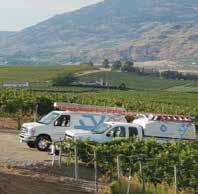
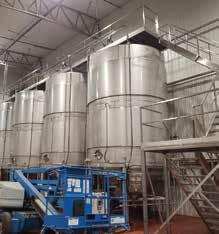








Two homes and a barn on 3.43 acres. Close to amenities, this Belgo hobby farm looks across the park at Southeast Kelowna for the same central country feel. Located near the end of the road, there aren’t many quieter, lower traffic locations in Kelowna. Featuring a large home with many updates, including an in-law suite, and a separate manufactured home. The main home has updated bathrooms and lots of light through large windows, as well as a vast covered deck. The 1 bedroom in-law suite is accessed from the walk out basement level. Lots of elbow room here, and space for all your hobbies and parking for all your toys. Previously there was a small orchard on the property, even cattle, but it is mainly planted lawn now. The 2 bedroom mobile was brought on new ’98 for family or farm help & features its own septic system. New ALR guidelines allow for secondary homes and City of Kelowna bylaws are under review.

This hard to find flat, usable 5.5 acre farm is in a quiet area of South East Kelowna that is great for cherry farming, backing on green space. Views out to Scenic Canyon Park and Gallaghers Canyon. Serene setting yet just minutes away from everything! Second to last property on a no through road. City of Kelowna water. Older 3 bed 1700 square foot home, put your stamp on it or build your dream home. Fantastic offering! GST may apply to a portion of the sale price.
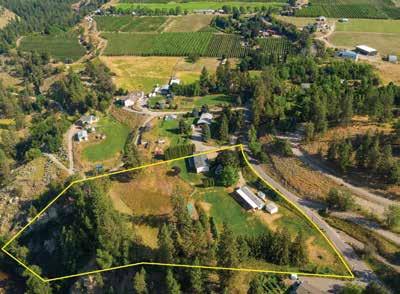
Trust the local team with over 37 years of combined experience in Okanagan farm sales to get it done. We offer the benefit of extensive farm knowledge, thorough client communication, and multi faceted worldwide exposure of our farm listings. We have countless connections to farm buyers from across the province and beyond who we are constantly in touch with. Our team has sold over 250 Okanagan Valley farms and truly understand the nuances and complexities that often arise during farm transactions!
Jerry grew up in the Kelowna area and his family has been farming continuously in the valley since 1904. Prior to forming the Geen + Byrne Real Estate Team Jerry was partners with his father Gerald Geen at RE/MAX Kelowna since 2003.

Elya and her family currently live on their cherry orchard in Lake Country, just across the valley from where her Grandparent’s orchard was. Elya was born and raised in the Okanagan and has been dedicated to real estate for over 15 years.

Shaun joined RE/MAX Kelowna in 2019 after managing one of the south Okanagan’s premium wineries for close to two decades. His comprehensive knowledge of the winery and vineyard business is first rate.
The Fortify conference is back in person for 2022.
Fortify Conference
November 15
Penticton, BC https://fortifyconference.ca/
Unified Wine & Grape Symposium

January 24-26 Sacramento, California http://www.unifiedsymposium.org
Pacific Agriculture Show
January 26-28 Abbotsford, BC http://www.agricultureshow.net WineVit 2023


Washington Association of Wine Grape Growers
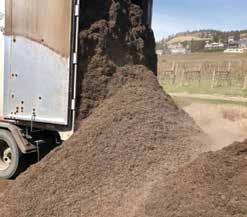
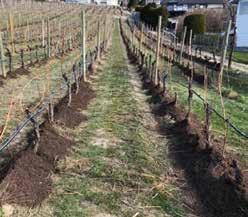
February 6-9 Kennewick, WA, USA https://www.winevit.org/

International Fruit Tree Association
February 12-15
Grand Rapids, Michigan http://www.ifruittree.org
Oregon Wine Symposium
February 14-15 Portland, Oregon www.oregonwinesymposium.com

Ontario Fruit & Vegetable Convention February 22-23 Niagara Falls, ON www.ofvc.ca
BCFGA Annual Convention
February 28 Location TBA https://www.bcfga.com/




The smart money is going to the wise, as Vancouver startup BarrelWise has closed a $3.1 million seed round.
Orchard and Vine has previously covered Barrelwise, which developed a clever technology allowing winemakers to measure SO2 levels 15 times faster than lab analysis.
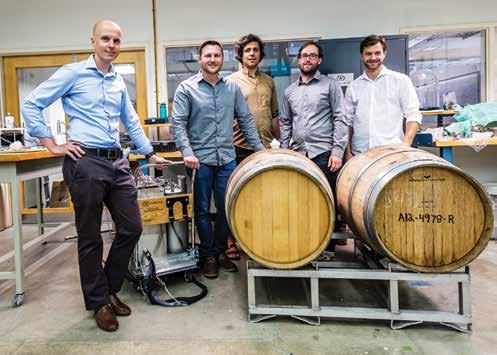
The company has since collected an impressive client list, including Andrew Peller, Frind Estate Winery, Arterra Wines Canada, and Mission Hill Family Estates. The rave reviews from customers has now helped Barrelwise attract seed capital, with the round led by Conexus Venture Capital through its Emmertech fund. Ag Capital Canada also participated in the funding round, and Conexus managing director Sean O’Connor has joined the company’s board of directors.
The idea for Barrelwise came about when one of the founders worked in the rum industry, and had an idea to help in the manufacture of products made in oak barrels.
“We came up with some rough ideas for technologies that could help to improve these processes, which were encouraged by winemakers that we knew,” said CEO Jason Sparrow.
In 2019, a year after the startup’s formation, BarrelWise joined the HATCH accelerator at UBC and started working full-time on the business.
After securing this seed capital, BarrelWise said it intends to “ramp up and support” its FS1 product. The funding will also be allocated towards expanding BarrelWise’s team to bring on key sales, marketing, and technical personnel, as well as bolstering the startup’s production and customer support capabilities.
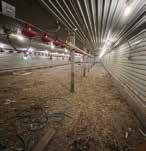
The system includes specialized bungs for each barrel and a unique cart. A hose with a head unit runs from the cart and attaches to each bung to take measurements while
also allowing for topping up in a single visit.
“What we’re building on top of this is the sensing. We had to start with this first system,” said co-founder Artem Bocharov. “We were in trial phase with several wineries for a while. Now their cellars are fully outfitted with BarrelWise bungs.”
Bocharov says the greatest advantage is the Barrelwise system lets winemakers know the sulphite level in every barrel, while greatly reducing the time and effort of testing.
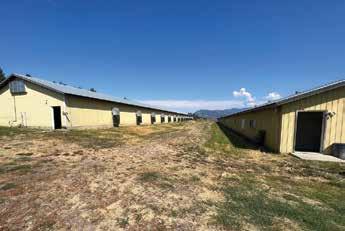
5 large well insulated shops fully serviced with water, gas, and power, interior and exterior metal siding, 10’ ceilings, totaling almost 50,000 sq ft. Shops have been well constructed with concrete floors and are in working condition for A2 zoned uses in the Township of Spallumcheen.
• MLS 10262298
• Base rent: $8.00 / sq ft.

• Space ranging from 4,000 – 50,000 sq ft.
for more information contact: GEOFFREY OLIVER oliver@coldwellbanker.ca 250.859.4043 cbcworldwide.com
37,000
There’s more good news for cherry growers, who now have access to the lucrative South Korea market.
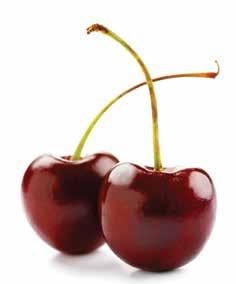
The growth of Canada’s cherry industry has been a major success story in the tree fruit sector. Now, the Minister of Agriculture and Food, Marie-Claude Bibeau, says Canada has gained access to the South Korea mar ket for BC growers.
Canada has been working collaboratively with South Korea to gain access for fresh cherries since 2015. Increased exports into South Korea has been part of British Colum bia’s long-term strategy to grow interna tional markets for cherries, while securing the best price.
British Columbia’s cherry industry produces 95% of Canada’s sweet cherries and has an opportunity to grow even more thanks in part to the premium new cherry varieties bred at Agriculture and Agri-Food Canada’s Research Centre in Summerland, British Co lumbia.
Sweet cherries have now become Canada’s second largest exported fruit crop behind blueberries. As the region in North America with the latest-growing cherries, British Co lumbia exporters have a competitive advan tage when the cherries are ready to go to market in August and September.
“With new access to the South Korean mar ket, growers in British Columbia can contin ue to showcase their cherries around the world and expand trading relationships,” said Bibeau.
When one cold night can ruin an entire year’s hard work...
It’s best to play it safe.
Since 1967, we have hand-crafted our wind machines with precision technology. Growers from around the world trust Orchard-Rite® wind machines to protect their orchards from the dangers of frost. We are dedicated to serving you by providing the tools and service to stave off those frosty nights, protecting your harvest and your future. Find us at orchard-rite.com.
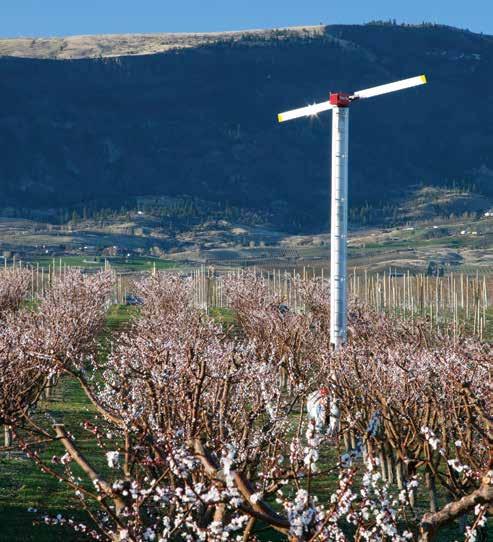
PrairieCoast is Orchard-Rite’s Only Authorized Sales, Parts & Service Dealer in BC, with Two Locations to Serve You!
Dallas Drive, Kamloops, BC 250-573-4412
prairiecoastequipment.com
Adams Court, Kelowna, BC 250-765-9765
The BC and Canadian governments are in vesting more than $1 million to support 10 new Agritech projects.
They say the investments are meant to sup port BC companies that are already devel oping technologies that will help farmers mitigate the impacts of climate change, and boost the province’s food security and food economy.
The program is administered by the Invest ment Agriculture Foundation of BC.
One such investment is going to Okana gan-based Geotronics Consulting Inc. and partner Vintality Tech Inc., who are receiving $192,022 to develop technology to reduce irrigation in vineyards.

“We’re very excited about this project and work with the Investment Agriculture Foundation of BC,” said Geotronics general manager Christopher Mark. “This funding has allowed us to hire a full-time employee dedicated to the project and get our tech nology trialed in vineyards. At a time when water-use is coming under justified scruti ny, we feel our project will allow more sus tainable and profitable farming in B.C. and around the world.”
The technology will reduce the water used, while maintaining vine health and grape quality. It combines precision viticulture sensor technology with new developments in wireless and mesh networking, the sys tem will allow real-time tracking of water use through sub-soil mapping.

Dicklands Farms FLP in Chilliwack is receiv ing $165,000 to help design and develop a low-emission dairy barn that will cap ture and clean barn air, and control barn
temperature and humidity. By combining cutting edge, commercially available tech nologies, Dicklands Farms aims to lower greenhouse gas emissions from the dairy sector, while giving dairy farmers the abil ity to control the environment inside their barns, keeping their cows healthy and safe during extreme weather and increasing productivity.
Docantheon Horticulture is developing a three-wheel electric-powered mini-tractor prototype that allows the operator to lie
face down as it rolls slowly down field rows and perform planting, hand weeding or harvesting tasks. Located in Victoria, Ross Borden is receiving $15,000 to build the ma chine, named Zero, as it requires zero extra bed space to operate and zero bending to plant, weed and harvest. The goal of Zero is to reduce worker fatigue while increasing productivity.
Projects under the Agri-Innovation Program have received more than $11.3 million from the Canadian Agricultural Partnership.

David Kozuki of Golden Retreat Vineyards was named the 2022 Viti culturalist of the year by the BC Grapegrowers Association.

President John Bayley, the viticulturist at Blasted Church, said Kozu ki personifies the spirit of the award, to recognize those “who strive to grow the very best wine grapes.”
Bayley said naming the winner was very difficult this year, as the other two nominees were John Pires of Phantom Creek and Gra ham O’Rourke of Tightrope Winery, both known for extremely high quality wines.
The Golden Retreat Vineyards were first planted by Kozuki’s grand father, and Bayley says that since inheriting the family farm, Kozuki has meticulously worked to produce some of the Okanagan’s best wine grapes.
“A short conversation with David in his vineyard and you get a clear sense for his vision and how he strives to grow the very best wine grapes,” Bayley said at the award ceremony.
“David is a farmer at heart, his family has a long history of farming in Summerland. The research and forethought he put into amending the soil and planting the vines paid off. There is no disease pressure nor pest pressure visible in his rows.

“There are many exceptional growers in BC,” Bayley added. “It is the detail in the vineyard and his perfectionism that made David stand out.”
Great grapes make for great wines, and the BCGA says that has been the case with the wines made from Golden Retreat Vineyards. For example, the Spearhead Pinot Noir - Golden Retreat has won multi ple awards, including a Platinum finish at the 2021 Lieutenant Gov ernor’s Awards for Excellence in BC Wine.
The BCGA’s Viticulturalist of the Year award is not just focused on recognition. The award includes a $2,000 bursary from event spon sor Cohort Wholesale to attend a viticulture conference or educa tional event.
Kozuki will also be a judge for next year’s award.

Gary Pilliteri and Paul Pender have been awarded two of the top honours in the Canadian wine industry, at the 2022 Wine Growers British Columbia Industry Recogni tion Awards.
The awards are presented by the major or ganizations in the industry, including Wine Growers Canada (WGC), Wine Growers Brit

ish Columbia (WGBC), Wine Growers Ontar io (WGO) and Ontario Craft Wineries (OCW).

“Today’s Canadian Wine Industry Awards have showcased our diverse industry, and everyone at Wine Growers Canada is hon oured to recognize the outstanding contri bution, dedication and expertise that all of our nominees and winners have provided.
Recognizing and celebrating these accom plishments is very important, to showcase the expertise and sheer hard work of our deserving winners,” said WGC President and CEO, Dan Paszkowski.
Pilliteri, the owner and founder of Pillitteri Estate Winery, was named as the recipient of the Canadian Wine Industry Award of Dis tinction, considered the highest honour in the country for this industry.
“For decades, Gary Pillitteri has been known for his work ethic and initiative, with a strong sense of family, giving back to his community, and an unwavering commit ment towards the pursuit of Canadian wine excellence,” said Paszkowski. “This award is a testament to Gary’s vision of building a world-class winery and a true family busi ness, with a devotion to growing the Ca nadian wine industry and producing wines that are sold around the world.”
But the most emotional moment of the awards presentation came when the late Paul Pender, who was murdered last year, was named as the recipient of the Karl Kai ser Canadian Winemaker Award.
The Karl Kaiser Canadian Winemaker Award was created in 2018 to celebrate great Cana dian winemakers, in honour of the legacy of the late Karl Kaiser, a Canadian wine indus try pioneer and viticultural visionary. Pend er, renowned for his innovative approach to winemaking, worked at Tawse Winery.
“With roughly 20 vintages, and an impres sive list of awards, Paul has crafted beautiful Canadian wines. His service to winemaking, his skills and talents, his passion and in novation, have all played a big part in not only helping create a love for wine, but also placing Canada on the world map of great wines,” said Paszkowski.
The organization also handed out several other prestigious awards, including:
• Canadian Wine Industry Champion Award - Debbie Inglis
• Wine Growers British Columbia Industry Recognition Award – Marjorie King
• Wine Growers British Columbia Award of Distinction – Josie Tyabji
• Ontario Wine Industry Champion AwardRafik Louli
WineGrowersCanada.ca.
Okanagan Specialty Fruits, maker of the famous Arctic apple, is expanding its executive team.
OSF says Daryl Johnston has joined the company as Vice President of Sales and Business Development, while Don Westcott was promoted to the post of Senior Vice President.



“Over the past five years, Don has proven to be a very dedicated and capable member of our executive team,” says Neal Carter, President of OSF. “I’d like to congratulate Don on his promotion, which is very well-deserved. While he will continue to play a central part in leading the company’s operations team, his new position will also see him take a more active role in strategic business matters,”
A Bachelor of Arts graduate from the University of North Carolina, Johnston joins OSF as a proven leader in generating sustainable and profitable growth in the fresh produce, frozen processing, and consumer packaged goods industries. He brings over 32 years of food and beverage experience to the OSF team, including work with Dole Fresh Vegetables, Southern Specialties, and most recently, Titan Farms Sales and Palmetto Processing Solutions.
“I’m thrilled to be joining OSF and bringing my skillset to this vertically-integrated company,” states Johnston. “Arctic apples are such an amazing product, and their superior freshness and 28-day shelf life offers new opportunities that are waiting to be explored. I’m looking forward to helping lead the company into a marketleading position.”



From our central Kelowna office, NCA Commercial Inc. is best placed to offer experienced, reliable and professional valuation and consult ing services to those owning and operating agricultural land and businesses in BC’s interior.

Our team of accredited commercial real estate appraisers specializes in a variety of services including:
Toll free: 1-844-644-7815 Local: 250-868-9244 www.ncacommercial.com

There are numerous challenges in vine yards and orchards throughout the sea son that affect yield and the long-term health of the plants. Late in the season is an essential time to ensure healthy, pro ductive perennial crops for the following year. At post-harvest, trees and vines are often at their weakest and are recovering from a variety of stresses.
After harvest, attention should be given to next year’s crop potential, it is vital to ensure trees and vines have adequate en ergy to facilitate healthy root growth, bud development, and early spring growth. The post-harvest phase is a critical time for absorbing nutrients and building car bohydrate reserves used for fueling new growth the following season. Trees and vines require adequate water to maxi mize the storage of carbohydrates and nutrient uptake. Post-harvest water stress can reduce root growth and permanently affect the photosynthetic ability of plants. The stunted root growth results in a re duction in the amount of water and min erals that the plant uptakes, which further impacts the photosynthetic ability of the plant. The reduction in photosynthesis can influence the potential for continued plant growth and flower development for the following season which can negative ly impact yield.
Post-harvest applications of Ascophyl lum nodosum derived biostimulant Stella Maris® are proven to be beneficial to orchards and vineyards to help with new season results and help maximize future plant yields. Multiple bioactive compounds found within Stella Maris help plants improve post-harvest quality, which has a positive impact in next sea son’s production. Many different biotic and abiotic stresses have the potential to impact a plant’s growth and develop ment, which reduces yield and profitabil ity. The use of Stella Maris gives your crop that advantage to reduce the negative impact of the abiotic stresses.
Post-harvest applications of Stella Maris will help improve:
• Fall root flush and increasing carbohydrate reserves.
• Natural plant resistance to stress.
• Supporting bud development.
• Avoiding early defoliation, which can decrease flowering, bud development, fruit size, and fruit set the following year.
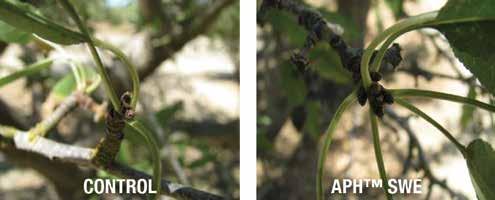
Stella Maris contains key polysaccharides (complex carbohydrates) that trigger an tioxidant production within plants. An tioxidants protect plants from pre- and post-harvest damage caused by harmful molecules called free radicals. Addition ally, the presence of fucose-rich polysac charides and other key bioactives such as alginates, betaines and mannitol help with natural chelation of nutrients
to make them more available as well as promote enhanced root growth and es tablishment.
Stella Maris encourages the production of proline (an amino acid) that strengthens cell walls within plants so that they don’t break down as easily post-harvest and protects plants against abiotic stresses.
Stella Maris is an easy-to-use water-solu ble liquid formulation ready to be used in tank mixes or nutritional blends. Superior blending properties allow it to mix well with other ingredients. Stella Maris can be applied post-harvest via foliar spray or soil application for 2-4 weeks following harvest.
Preparing for next season starts with Stella Maris. For more information, visit AcadianPlantHealth-NA.com to find your crop application program.
Applying Acadian Plant Health™ sea weed extract enhances root growth, particularly during periods of natural root flush. Increased root growth leads to increased ability to uptake water and nutrients.
Increases in root growth were evident on these own-rooted ‘Merlot’ grape vines. The roots of both vines were pruned to the same length. After four weeks, the APH SWE treated plant (right) had a much larger increase in root mass than the Control vine (left).
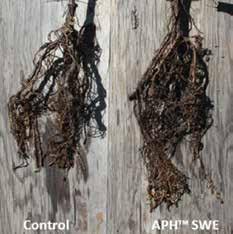
Harvest takes a toll on trees. Stella Maris ® post-harvest applications enable your trees to store more carbohydrates and nutrients, recover faster from the season’s stresses, support bud development and root growth. Maximizing future yield starts with a post-harvest application of Stella Maris.

more information, go to
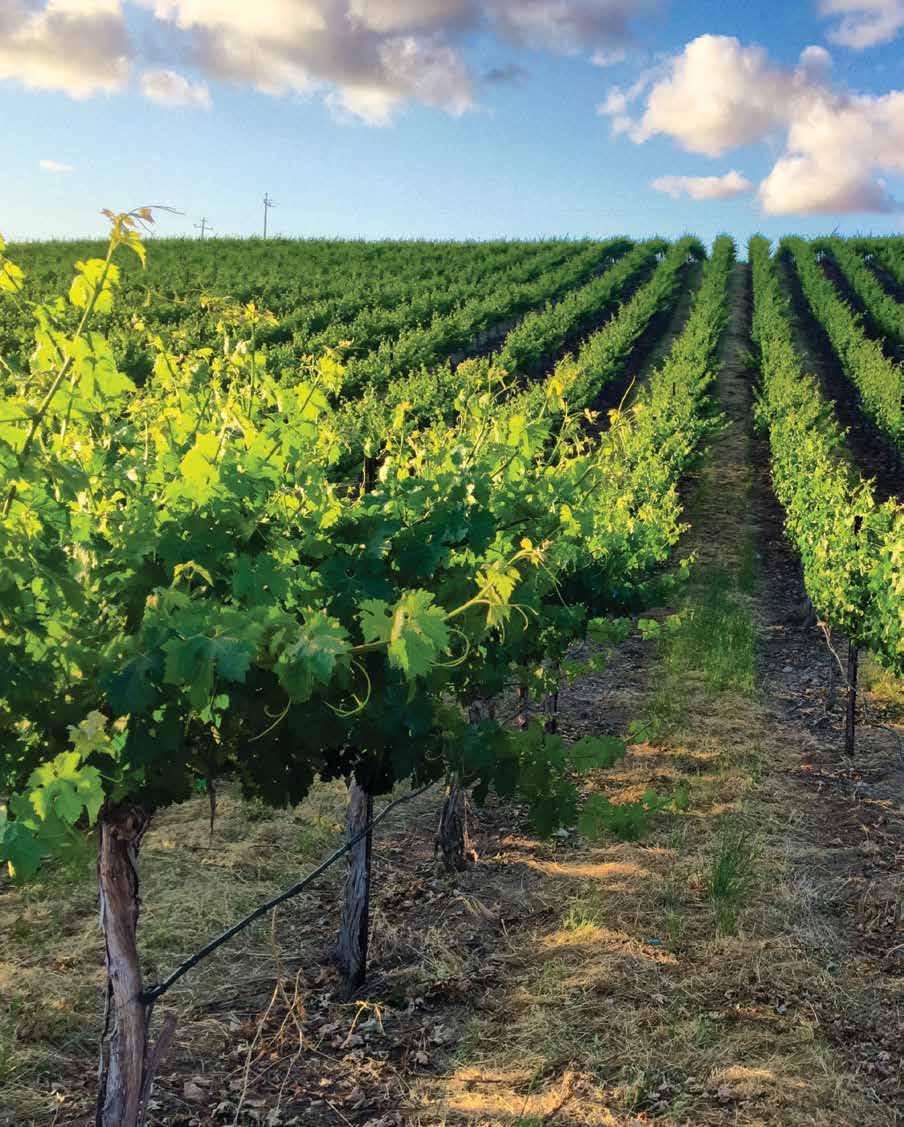

There is a long tradition in the wine industry of using enzymes to degrade grape pectin. A large part of the pectin molecule can be split by specific enzymes - pectinaseswhich include polygalacturonases, pectin methyl esterases and pectin lyases. These enzyme activities primarily affect certain sections of pectin, however, known as the smooth regions, that predominantly consist of polygalacturonic acid chains that are partially esterified with methanol. The pectin macromolecule’s structure is much more complex, though, also containing the strongly branched, or hairy, regions, that are characterised by side chains consisting of a variety of other sugars, primarily arabinose and galactose.
An increased presence of those side chains makes the processing of hybrid varieties particularly difficult.
Arabinogalactan II (AGII) here represents the pectin fraction which can be degraded only to a very limited extent with conventional wine pectinases and is therefore responsible for clarification and filtration problems.
In Trenolin® FastFlow DF, Erbslöh offers a highly concentrated wine enzyme that has been developed specifically for this use. It can be added at crush, but also later in the wine stage to improve filterability and clarification. Trenolin® FastFlow DF is a combination of various classic pectinase activities, such as polygalacturonase and pectin lyase, with a novel enzyme activity: arabinogalactan II-hydrolase (AGIIH). AGIIH can split the hairy regions and allows significant improvements in colloid degradation, and therefore in the processing properties of juice and wine. The influence of the individual enzyme activities in Trenolin® FastFlow DF on grape pectin degradation was investigated in a laboratory test on Concord grapes. This grape variety is especially difficult to process from a technical viewpoint as it has a tough skin and contains a lot of hairy pectin. The batch was analysed using gel chromatography. Degradation of a large part of the pectin into small cleavage products was clear to see (Fig. 1). A proportion of the macromolecular fraction
Figure 1: Enzyme effect of a classic wine pectinase on grape total pectin. The black graph shows the sample before enzymation, the red graph the sample after enzyme treatment.
Figure 2: Enzyme effect of AG II hydrolase on the pectinase-resistant fraction of grape pectin. The black graph shows the sample before enzymation, the red graph the sample after AG II hydrolase treatment, which led to a complete degradation of the pectinase-resistant fraction.
proved to be pectinase resistant, however. Sugar analysis of the hydrolysed fraction predominantly resulted in galacturonic acid, proof of the strong effect on smooth pectin, polygalacturonan. The unsplit pectin fraction consisted exclusively of arabinose and galactose-containing pectin, arabinogalactan II. The second enzymation stage was to investigate subsequently the effect of AGIIH. For this, the pectinaseresistant pectin fraction was isolated and reset to the natural concentration. After treatment with AGIIH a gel filtration analysis was carried out again (Fig. 2). The

complete remaining polymer fraction was split enzymatically into the monosugars arabinose and galactose. Enzymation with classic pectinase and AGIIH led to complete degradation of the total grape pectin.For the winemaker this means, increased filtration rates and better clarification properties in wines from pectin‐rich grape varieties.
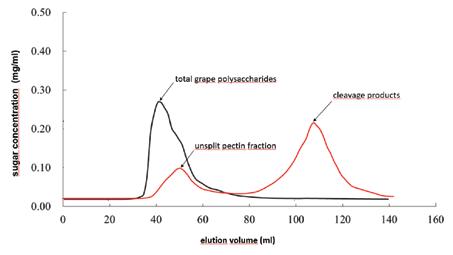
Waiting makes the end result that much sweeter, or so said our parents when we were pajama’ed children waiting to open our Christmas gifts. But, in the case of Code Wines, the wait really has created a beauti ful gift for wine lovers.
Opened in mid-June 2022, Shay and Har lee Code’s winery, east of the southern tip of Skaha Lake, came about after years of searching for the right property to blend Shay’s childhood roots in prairie farming with the couple’s shared appreciation of wine.
They bought the 13 acres in 2016 and in 2017 started planting what is now 10,000 vines covering five acres. In June 2021 the house and winery were completed and in November their liquor licence was ap proved.
“We were actively looking for over a de cade,” Harlee says. “Looking for the perfect spot. We just kind of stumbled upon it by
accident. We had some soil testing and just different things we needed to look at and I think we purchased it within a week.”
Although they explored some US states for properties, they felt Canada was the place to be with BC wines growing in popularity on the world stage. And it was hard to beat the property they found. Rocky, hilly, cliffs, steep slopes and a bit of valley floor are just a few aspects of the diverse terrain.

“We just knew it was the perfect spot for us,” she says. “A beautiful view of the village and the lake. We’re adjacent to the nature’s trust and that also makes this spot super special.”
To their knowledge, the site has never been farmed, leaving an opportunity for the vines to naturally grow in the undisturbed soil.
The crushing and production for the first three years of grapes were done slightly north of their property at Roche Wines on Naramata Bench east of Penticton. The rela tionship Shay and Harlee established with Dylan and Penelope Roche is a continuing
one, making it a little easier for the Codes to find their footing in BC’s Okanagan Valley wine region.
“We’re hoping to stay small, under 1,000 cases,” Harlee says. “Never say never, but we’re focusing on the grapes and high-qual ity wines.”
A single-site estate winery, Code Wines has nine blocks (five acres) currently plant ed with Chardonnay, Pinot Noir, Syrah and Viognier.
“Part of it is driven by our soils and our loca tion and what grows well in our area at this specific site and kind of the style of wines we want to make,” says Harlee.
When questioned about having the heavy, spicier Syrah in the same vineyard as the lighter aromatic Pinot noir, Shay explains that Syrah is known for growing just about anywhere. They’ve planted three blocks of it in the hottest areas of the vineyard.
“The birthplace of Syrah isn’t that far from
the birth place of Pinot Noir, maybe three kilometers apart,” he says. “So, they’re not as strange of bedfellows as you might think.”
The Codes have taken Pinot Noir under their wing; not quite to the extent of their chil dren Thomas and Molly or Golden Retriever Poppy, but pretty close. They’ve been grow ing a variety of Pinot Noir clones and pro cessing them individually to allow people to taste the differences from one to the other.
“We’ve got a clone project going on,” Harlee says of the Pinot Noir. “We call it the Clone Collection. Because we’re small and want to remain small, we decided to separate out our clones and process them the same and separately.”
The clone varieties include Pommard 91, Dijon 115, Dijon 77 and one with uncer tain, though likely German, lineage they call Ancestor 01. Together with their Pinot Noir 2019 estate blend and the 2020 estate blend, they’ve packaged the six bottles to gether to make up the collection.
“We’ve had a really good reception,” Shay says of the collection. “That’s been our best seller, the Clone Collection, even better than anticipated.”
This fall will be interesting for the Codes as it will be the first time they harvest and pro duce wines on site. The winery is tiny, just 500 square feet with a tasting room built in, which will make logistics interesting as they navigate the first batches.
“We’re very modest,” Shay says. “Nothing fancy or big. We use the space well. We’re doing tastings right in the production facil ity.”
The Codes also say they will be working closely with the Roches again.
“They’ll be around just to make sure we don’t do anything silly,” he says. “Basically it’s just hands-on over the last three years working alongside Dylan and Penelope, both of us participating at different times. They’ve just been incredible in helping us and guiding us.”
The Codes are farming organically. Part of it is because they live on site and the family does all of the farming, but it’s also because of a desire to not add anything to the land that wasn’t there previously.
“We really want to be stewards of our land and the environment,” Harlee says. “That’s important to us as a value. Living here is a beautiful thing. When we see the bighorn sheep and rattlesnakes and birds building nests in the Chardonnay, you just have a bigger sensitivity to it.”
Taking the Clone Collection a step further, they’ve begun a similar project with the Syrah. One block is on traditional trellises and another, which is on very steep hillside, is planted in the sur echalas style with each vine on its own stake.
“It’s a fairly dense planting,” Shay says. “All farmed by hand. This style is very common
from the birthplace of Syrah which is just south of Leon. A lot of their plantings are on very steep hillsides along the Rhone River.”
There are two clones in the Syrah plantings. One is of unknown origin and the other is a combination of Syrah 07 and another clone called Syrah Joseph Phelps, which Shay be lieves has not been planted in Canada previ ously. He’s following in the footsteps of Wal la Walla’s Christophe Baron with this variety.
“I’ve had a bromance with what he’s been doing for many years,” he says. “He makes unbelievably great Syrahs.”
While he admits there is plenty for them to learn about on the wine side of things, he feels his childhood spent farming in Saskatchewan has served him well on the growing side.

“My farm background has been pretty help ful,” he says. “The next mountain to climb is going to be the winemaking side.”
Fortunately, they have plenty of support. Harlee says the community around them has been nothing but helpful with guidance and enthusiasm for newcomers to the local industry.
“The wine community here is just really sup portive and everyone seems to collaborate and share,” she says. “Everyone is willing to talk about what they are witnessing and what they are doing. It’s been a great expe rience for us.”
 By Gary Symons
By Gary Symons
Plans to move all packing house operations to Oliver have created a rift within the BC Tree Fruits Cooperative.
The move caught growers by surprise, as the Co-op had purchased land on Old Ver non Road in Kelowna, and planned to build a large packing house operation in that lo cation.
In August, however, the BC Tree Fruits man agement and board announced that plan had been cancelled, and that it would only be operating one packing house, located in the town of Oliver.
As the BCTF explained, “The situation changed, so the plan had to change.”
That news has led several growers to con demn the decision, accusing the coopera tive of failing to consult with the member ship. Many of those growers also staged a noisy protest, holding up signs reading “Dic tatorship” and “We Have No Voice.”
One of those protesters, Sukh Khun Khun, told reporters he felt such a critical decision should not have been made without the in put of the co-op members.
“I’m here because a decision was made, without the consultation of the mass ma jority, to move facilities to another city, that just financially, economically and morally does not make sense,” Khun Khun said. “So who is benefiting from these decisions? That’s the question we have; who is benefit ing, because as you can see behind me, the growers do not feel like they are the ones benefiting.”
Several of the growers at the protests ar gued it didn’t make sense to sell the original Lake Country packing house, and then buy property for a new packing house in Kelow na, only to cancel that plan and open one in Oliver, two hours drive to the south from growers in the Vernon area.
“When they make such a big decision it should be a general house meeting, not just the directors. The growers should have a say in it,” said Gurjit Pabla.
But BC Tree Fruit Cooperative CEO Warren Sarafinchan told Orchard and Vine that the board was forced into a change of plans by economic forces beyond its control.
“We’ve been actively talking about the need for consolidating our operations for some time, and in fact the discussions go back to 2011 and 2012,” Sarafinchan said. “The need for this project has been recognized, and with the purchase of the property on Old Vernon Road, and the discussions that have taken place, that seemed to be the lead option, and quite frankly, our manage ment team worked extremely hard to find an option that would have seen that facility built in Kelowna.
Hardev Aujla“But I think its important to recognize how much the world has changed over the last couple of years,” Sarafinchan added, say ing a combination of factors had made the Kelowna project economically unviable.
“Construction costs are increasing by, in some cases, 20 and 30 per cent in the last couple of years. When you factor in increas es in construction costs, increases in interest rates, and then there’s also a level of urgen cy to get our returns to a more sustainable level for our growers.
The board of directors broke our trust, they betrayed us…
The CEO, he circulated video every week, but he never mentioned anything about this move.Photo credit: @bctreefruits
“The difference is, we could have this proj ect completed in Oliver for the 2024 crop, and in fact, the first phase will take place for the 2023 crop. So, we can start to increase grower returns and see benefits from this project as early as next year.”
Sarafinchan explained that as the board was weighing its decision, it was primarily motivated by its primary goal, which is to increase the monetary return to growers for their fruit.
When it came time to do the math, he said, the changes in construction costs and inter est rates, combined with the much longer time it would take for the Kelowna packing house to come online, meant the original plan no longer made financial sense.
In fact, Sarafinchan argues that most grow ers would likely have been much unhap pier had the Kelowna project gone ahead, because it would have delayed increases in returns for their fruit by two or three years.
As well, the co-op itself would have faced a much larger debt load, and would not have as much money to help growers through tough times.

“I’ve consistently heard from the day I start ed, we have to get our returns up as quickly as possible,” Sarafinchan said. “I’ve literal ly heard that from day one, and we have to get our financial house in order, which we’ve done, so we are now able to invest and grow, and this is the path that will get our growers the highest returns the fastest, while carrying substantially less debt.”
One of the factors is that expanding the op eration in Oliver can be done much more quickly and at lower cost than building a new packing house in Kelowna.
“With the Oliver option, we can start in creasing those returns in 2023 and more so still in 2024,” Sarafinchan said. “With the Kelowna option, that site wouldn’t be op erational until 2025, so when you factor in all of that, it becomes clear that all of those variables together make Oliver the right choice for the cooperative.”
O&V also asked Sarafinchan why BC Tree Fruits had not consulted with its growers before making the decision to cancel the Kelowna packing house in favour of a single operation in Oliver, a move that infuriated many of the growers at the protest.

“The board of directors broke our trust, they betrayed us,” said Hardev Aujla, a grower from Vernon. “We chose them and they did represent us. The CEO, he circulated video every week, but he never mentioned any thing about this move.”
But Sarafinchan said the board was unable to reveal the decision earlier due to its hu man resources policies.
The main reason is that BC Tree Fruits has a strict policy that it will not publicly reveal decisions that affect the jobs of its workers,
We have to get our financial house in order, which we’ve done, so we are now able to invest and grow, and this is the path that will get our growers the highest returns the fastest, while carrying substantially less debt.
BCTF CEO Warren Sarafinchan.
until all of the options have been discussed with those employees. In this case, Sarafin chan said there are 95 employees who will be impacted by the change, and while all of them would be offered a position in Oliver, that would still entail them having to move their homes in order to continue working with BC Tree Fruits.
“Whatever the decision would have been, it was going to impact people in our busi ness,” Sarafinchan explained. “One of our values is we treat people with respect and when we look at a decision like this - and in this case there are around a hundred roles that are going to go away - to have a consul tation with the broader grower community on that would not have been appropriate, so we did that out of respect for our team.”
The plan originally was to meet with grow ers and unveil the plan in detail at a live meeting at the Ramada Hotel in Kelowna, but that meeting was cancelled after the hotel raised concerns about security issues. “We absolutely wanted to sit down with our growers and have this conversation in a live environment,” Sarafinchan said. “In this particular case we got a call from the venue asking us to put (security) measures in place that would have been impossible to secure in the amount of time that we had. So, rec ognizing the concern that the venue raised, we felt we just couldn’t get those resources in place, and so we had to move the meet ing on to Zoom, (but) we ended up with a good turnout.”
BC Tree Fruits also immediately rescheduled the live meeting with growers, staging one in Oliver and one in Kelowna.
Many of the growers who oppose the deci sion are located in the North Okanagan, in and around Vernon.
Mike Mitchell, the owner of B&T Orchards in Lake Country, argues it doesn’t make any sense to ship fruit two hours south, and then ship the bins back to the north
”You can’t transport apples when it is 20 be low and then all of sudden the highway in Summerland gets shut down and that food is frozen. The biggest concern for the grow ers is the distance the fruit is going to have to travel. The consumer wants a perfect ap ple. Every time an apple gets a little bruised it costs the growers money.”
Sarafinchan, however, says the BCTF’s board has carefully considered the problems and
costs of shipping, and that past experience tells them the fruit can reliably be shipped that distance without impacting quality. He also said moving the location to Oliver will not affect grower operations at all.

“You brought up an important question, which is, where will growers deliver their product in the future,” he said. “For all in tents and purposes, where growers deliver products today will effectively be the same.
“We will be transferring the fruit down to Oliver, but we already do that to an extent today. On the other side, we also have fruit moving from the South Okanagan and Similkameen Valleys to operations in the north, so there has always been fruit mov ing in both directions.”
On cost, Sarafinchan said the co-op’s man agement has crunched the numbers. “We have built that cost into the business case, but the decision is still very clear that Oliver
is the place for the cooperative to be in the future,” he said.
Despite protests by some growers, Sarafin chan believes most support the decision, and understand the board had to make a choice that benefits all members of the co operative.
“A cooperative by definition is a sort of ex tended family,” he says. “We’re not all going to agree, but the right decision has been made in the best interests of all growers.
The changes for growers in the north will be very minimal.
“I understand why growers are saying they want to be consulted, but it is the board’s role to make decisions that are in the best interests of all the growers; not northern growers or southern growers, but all grow ers within the organization, and that’s what our board did.”
The team at Blasted Church Vineyards is cel ebrating 20 years of operations in Okana gan Falls and raising a glass to a bright fu ture under relatively new ownership. As the future promises to bring more outstanding wines and plenty of accolades, here is a look back at some of the highlights in Blasted Church Vineyards’ history.

The year was 2002 when the Campbell fami ly acquired Prpich Hills Winery and Vineyard in Okanagan Falls to create a new, irreverent winery they renamed Blasted Church Vine yards.
The Blasted Church team didn’t just con ceive the name from a shrewd marketing idea; the team is also paying homage to the true story of a local treasure.
The name refers to the iconic house of prayer in Fairview that endured a controlled blast in 1929 to move it to Okanagan Falls.
A controversial topic, the name and mild ly blasphemous stance arguably is Blasted Church’s most notable characteristic.
On a beautiful plateau in Okanagan Falls overlooking Skaha Lake, Blasted Church sources fruit from their estate along with fruit from contracted growers in Oliver and Osoyoos. Originally planted in the early 1970s by previous landowner Dan Prpich, their estate vineyards are some of the oldest in the Okanagan Valley.
With the slopes and angles of the estate vineyards tricky to maneuver for even the most sophisticated of harvesters, for quality control the Blasted Church team insists on handpicking.
When Blasted Church Vineyards first burst onto the Canadian wine scene, the winery made an instant and lasting impression with the colourful labels that adorned its bottles.

Blasted Church launched its inaugural vintage with labels illustrated by White horse-based artist Monika Melnychuk. Bold and witty, the 2002 Pinot Gris depicted wellknown characters in the BC wine industry such as journalists Tim Pawsey and Jurgen Gothe attending mass.
In 2005, Blasted Church became the first BC winery to move to screw cap closures com pletely, and soon after became the first win ery to get introduced to the on-tap market, available at Tap and Barrel.
The winery has become a place where peo ple gather. Some of the most fun Okanagan Wine Festival after-parties were at Blasted Church.
For example, after the Festival’s Grand Fina le tasting finished on Thanksgiving week end, the midnight service at Blasted Church started. The shuttles lined up at the Pent icton Convention Centre brought ‘sinners’ who had tickets. On-site, they enjoyed a BBQ feast and music by Gospel Experience Choir until past midnight. Some people still miss it to this day.
As a nod to these much-loved parties of the past, for their 20th anniversary the winery held a “Seven Deadly Sins” themed party
complete with attendees dressed up as their favourite “sin”, such as music, food, and of course, the wines!
Owner Sean Morrison welcomed everyone and said he is so proud of the entire team, noting “they are elevating their guest ex perience to match the high quality of the wines that they produce!”
In 2008, the winery hosted Governor Gen eral Michaëlle Jean, and the winery team invited BC grape growers and everyone involved with the winemaking at Blasted Church to meet her.
The release of Blasted Church’s first tradi tional method sparkling wine was a special occasion. The winery team decided to cele brate the summer solstice, on June 21st.
Every single bottle of OMG enjoyed that day was sabered with a few very foamy at tempts at the end of the day when the wine was not as cold anymore. The solstice must
have brought OMG good luck, because to this day, this is one of the most awarded wines produced by Blasted Church.
Speaking of bubbles, to celebrate its 20th anniversary as a winery, winemaker Evan Saunders has crafted two special edition wines (The Dam Flood blend and a Char donnay) sporting the winery’s beloved first-generation label, originally released in 2002. The Dam Flood is a supple, juicy at tack of red berries and plum that flows into the savoury mid-palate and through into the rounded finish - beautiful with a light chill on warm summer days! The Chardon nay is a vibrant attack of citrus and orchard fruit that leads into the beautifully textured mid-palate, along with lemon curd and a floral note through the fresh, balanced fin ish. Enjoy with religious abandon at blasted church.com
The year 2020 was challenging for every one, and especially for the team at Blasted Church.
When the world shut down, the winery had to pivot. With no customers coming through the doors, the solution was to of fer direct-to-consumer sales through their website. Every order included a handwrit ten card with words of encouragement, co louring pages and crayons.
When summer finally arrived, the Christie Mountain fire threatened the winery and vineyard, and the winery had to close while the team was evacuated for six days. Many staff members were also evacuated from their homes!
When the team was permitted back to the property, they witnessed helicopters fill ing their buckets in Skaha Lake and flying directly overhead, sometimes so low they could feel the drops of water falling from the buckets. To show gratitude for the fire fighters’ life-risking efforts, the winery team painted a big “Thank You” on the parking lot pavement for the crews to see, still visible today.
In summer 2020, Sean Morrison purchased a majority interest in Blasted Church, and after founding owner Evelyn Campbell an nounced her retirement in the fall of 2021, Sean took over active management of the company.
Evelyn is now enjoying the retired life at her residence in Revelstoke, BC, while maintain ing a minority shareholder investment.
Sean has been fortunate to have worked with many of Canada’s leading brands and businesses including The Keg, Lululemon, A&W, Aritzia, Mr. Lube, Boston Pizza and Air Miles Canada, and he was attracted to Blasted Church because of its status as an iconic brand in the BC wine industry. Sean brings his experience with leading Canadi an brands to his work with Blasted Church’s award-winning wines, iconic branding and experienced management team.
In the past 18 months, many things have changed. The world started opening again, visitors are back to the tasting room, and new team members have come on board.
What has not changed is the team’s wish to continue to produce top-quality wines that reflect the Skaha Bench terroir and impress critics in Canada and beyond.
While showcasing wit and an often irrever ent sensibility, the team at Blasted Church is all about the production of serious wine. The team applies progressive farming prac
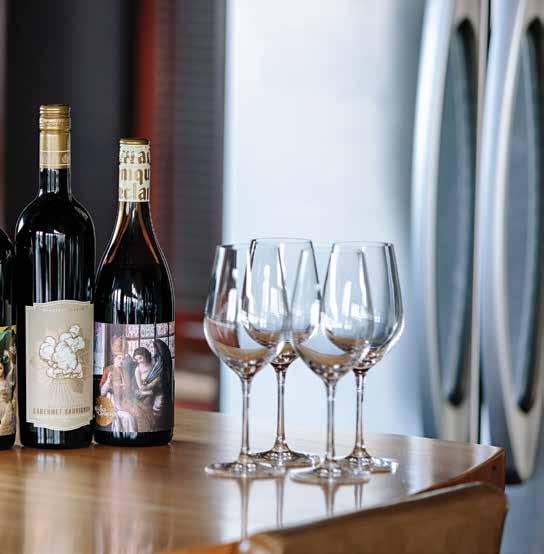
tices to produce handcrafted, small-lot wines that have gathered accolades from the most respected wine critics in Canada and beyond.
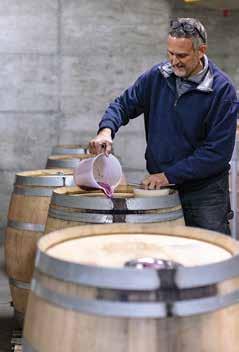
Landing the accolade of #2 ranked winery in BC and #3 in Canada by WineAlign’s Na tional Wine Awards in 2021 is a win the win ery team is very proud of.
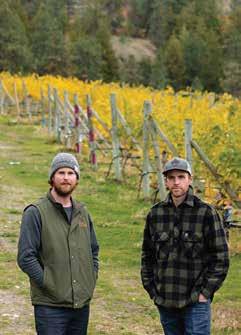

Visitors to the winery can experience a taste of the sublime, taking in their choice of heavenly wine and food experiences while enjoying the incredible Skaha Lake views from the tasting room or pool area. To join the flock, visit blastedchurch.com.
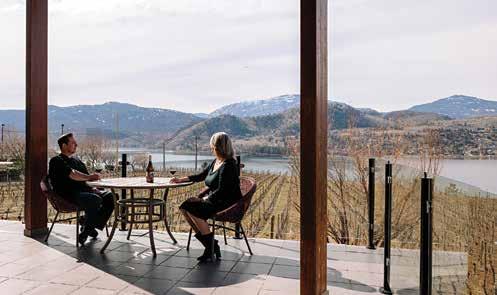
During the Christie Mountain fire the winery team painted a big “Thank You” on the parking lot pavement for the fire fighting crews to see.
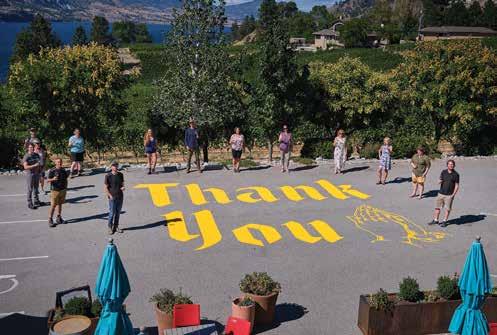
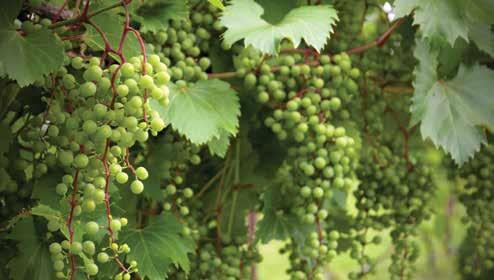 By Gary Symons
By Gary Symons
Ontario wineries are facing the grim realities of climate change, as extreme winter weath er has effectively cut the 2022 grape crop by half.
Winemakers in the region say the freezing temperatures last winter badly damaged the vines, with production this year estimat ed at just 42,000 tonnes, down from 82,000 in 2021.
Steve Byfield, a winemaker at Nyarai Cellars, told CBC Hamilton that farmers are now looking at adopting new grape varietals to deal with the more extreme variations in weather brought about by global warming.
“Climate change is impacting how we look at what grapes we can grow in the Ontario market,” Byfield told CBC Hamilton. “I know in France they’re breeding newer clones of different style grapes that will hopefully withstand and stand up to the changing climatic conditions that we’ve been seeing over the last five or six years.”
The situation is so bad this year that Byfield’s colleague, director of marketing Sharon Lit tle, says growers are unable to meet their contractual obligations.
“Some of them ... their contracts with the larger wineries are just barely being fulfilled, or may not be able to be fulfilled because of the damage, and then we lose out too, of course, because … we only buy a small amount from here and there and every

Frontenac grapes are a French-American hybrid, created in 1978 by University of Minnesota breeders and introduced in 1996. The grapes are particularly known for their resistance to the cold, but will they withstand extreme heat.
where,” she told CBC Hamilton. “So, it’s defi nitely hard for us.”
The Grape Growers of Ontario is also sound ing the alarm over the climate-related disas ter.
“With the vines literally dying, we don’t have a crop, a significant crop,” Zimmerman said, adding this is a long-term problem. On the one hand, global warming is bringing hot ter summers that can damage cool climate grapes, and on the other, causing wild weather swings that can result in unusually cold winters.
Both pose critical problems for growers.
“Climate change has an overall impact on the extreme weather swings, which ulti mately are putting pressure on consistently growing a crop,” Zimmerman explains. “The disease pressures from invasive pests and grape virus issues are heightened by the swings in climate as well.”
This year the crop crisis was caused by a variety of factors that all combined to cre ate a deadly environment for grape vines. Because the autumn of 2021 was unusually wet, grapes were left hanging longer than usual, and December also saw very wet weather, causing the sap to stop running through the trunk of the vine.
All the professional fertilizers, crop protection products, seed and supplies you need for your growing operation - organic or conventional - are now available locally in the Okanagan. Call us today and experience our top-notch service.
110-235 Beaver Lake Court, Kelowna Tel: 236-766-1516 www.tlhort.com
That was followed by a deep freeze in January that killed or dam aged grape vines across southern Ontario. For that reason, the im pact on grapegrowers will be felt over the longer term, as many farmers will have to replant at a cost of up to $45,000 an acre, and no revenue coming from those new vines for five or six years.
The Grape Growers of Ontario is now working with the federal and Ontario governments on a disaster package, primarily aimed at helping farmers with the costs associated with crop loss and re planting programs.

The emergency funding program that GGO is asking for would be similar to what happened in British Columbia after floods, super charged by climate change, devastated farmers in the Fraser Valley.
One of the problems for farmers is that crop insurance only covers the costs for a single year, but in this case, the decline in revenue from lost vines is a long-term hit.
So far, it appears the Ontario government is committing to:
• an additional $10 million in 2022–23 for ongoing support and expansion of the Enhanced Agri‐Food Workplace Protection Pro gram to help farms and agri‐food operations take additional mea sures to support the health and safety of agri‐food workers;

• $10 million COVID recovery fund for Ontario wineries and cideries to help them address the challenges posed by COVID. Wineries will be able to use these funds to invest in many activities including promotion, market development and tourism recovery;
• Expanded, multi-year funding of the VQA support program through 2024/25.
However, experts in climate change and agriculture say Ontariolike other wine regions - faces a much larger problem with longterm implications.
Elizabeth Wolkovich, associate professor of Forest and Conserva tion Sciences at UBC, is studying how global warming will affect wineries and grape growers, with a focus on the Okanagan Valley and regions of California.
“The grapes used in wine are very sensitive to changes in the weather, which is part of what makes wine so interesting,” Wolkov ich says. “But, that means grapes are also sensitive to long-term cli mate changes.”
On the positive side, that means that Canada may see new regions opening up for wine production, and already, that’s happening in provinces like Quebec and Nova Scotia, where wine production was almost unheard of a decade ago.
But on the negative side, the extreme weather swings caused by global warming also make it difficult to achieve predictable results, or to avoid disasters like the one faced by Ontario farmers this year. In France last year, crops were similarly devastated by a severe cold snap, causing the loss of one-third of the grape harvest. As a re sult, the world’s most famous wine region in Bordeaux has now ap proved six new varietals that can be used in a Bordeaux wine, all of them chosen not just for their flavour, but their ability to withstand the extreme variations in weather caused by climate change.
Experts like Wolkowich says growers across Canada will also need to look at hardier, climate resistant grapes, and at new areas for grape production.
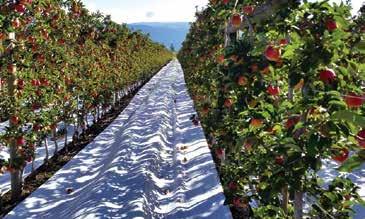

The Elliott variety of blueberries has been hit hard by scorch virus this year, but it’s far from the only varietal that’s susceptible.



Elliott blooms later and therefore sees high er aphid concentrations during bloom, making it a likely target and host for scorch. Unfortunately, bushes can’t be sprayed for aphids during bloom due to pollination, and there are no safe varieties to switch over to, explains Michael Dossett, breeder and geneticist with BC Berry Cultivar Inc.
“There are no varieties with immunity to the disease,” he says.
The tiny aphid is the chief promoter of scorch which transfers it from one plant to another, making it possible to wipe out large acreages quickly. Rhonda Driediger, owner of Driediger Farms, has already had to remove and replant 26 of her 105 acres in blueberries.


“It’s wildfire,” she says. “It’s everywhere.”
Once infected, plants will start to look burnt – hence the name of the disease – and will gradually develop yellowed leaves which will die. Blossoms will decrease in number and in time the plant will die. No prevention is currently available, other than to spray for aphids, but this strategy is far from fail-safe.
Aphids will leave a long legacy of destruc
tion behind them as they travel from plant to plant, creating a slow and expensive death in an invasion that farmers have no real weapons to fight.
Driediger pled the case of growers on June 4 to Lana Popham, BC’s Minister of Agri culture and Food, when the pair inspected Driediger’s fields.
“[Growers] have to remove and replace the field and this requires financial encouragement,” says Driediger. “It’s probably going to be six or eight thousand acres that will be infected.”
That could entail a loss of nearly 30 per cent of BC’s 27,000 cultivat ed acres.
While the Ministry of Agriculture and Food says it is aware of the increasing concerns, there have been no indications of funding for replants, which is what Driediger says the industry needs.
Carolyn Teasdale, an industry berry specialist with the ministry, con tinues to assist growers by staying in touch, sharing information and providing updates about strategies.
Recommendations for control are no different than they were when the disease was initially identified in BC in 2000. Growers need to control aphids, test suspect plants, and remove those that are in fected.
The BC Blueberry Council has a number of scorch-specific fact sheets and a video on its website under the resources section.
A much anticipated and discussed variety called Calypso has been popular among growers. BC Blueberry Council research director Eric Gerbrandt says, “It may surpass Elliott to become the third most widely planted cultivar behind Duke and Bluecrop.”
There’s no wonder it’s growing in interest given that it’s a mid to late season variety, so it will have fruit for first harvest later than Bluecrop and Draper, but earlier than Liberty and much earlier than Elliott, Aurora and Last Call. It requires several picks and depending upon when it’s picked, it either stays firm for two weeks or longer in a cooler, or it may increase in firmness.
Despite the positive timing of Calypso, it does not have resistance to scorch, simply because no varieties do.
“Some varieties, such as Bluecrop, tend to tolerate it much more than others,” says Dossett. “Everyone is struggling to figure out whether replanting with blueberries right away is the best course.”
Although Calypso isn’t the answer to scorch, it does have a lot of positives in terms of its firmness. Gerbrandt notes delaying first pick may improve quality of the second pick. Second pick also improves in firmness over time in storage, perhaps beyond seven weeks.
Testing continues and Calypso may be a great option, but Ger brandt says it has drawbacks, as do all varieties. It did not fair well during the 2021 heat dome, exceeding the damage sustained by Duke, and it may have a “mealy” texture at certain times. These may become small concerns. With higher yields, berry size, better flavour and larger fruit than Draper, Calypso may be the next choice for berry growers.
While Scorch is widely believed to be the cause of widespread damage to BC blueberry crops, Genome BC has a different theory.
The not-for-profit organization believes a new, mystery disease may be the cause, and it has provided funding for scientists to investigate.

The reason is that, when some visibly damaged bushes were tested, the results came up negative for both Scorch and for Shock virus.
Genome BC project manager David Charest says it’s important to investigate this new disease, to genetically identify it, and to find the right method to combat it.
“The time is right to have new tools to manage this better going forward and reduce the impact on blueberry production in B.C. and abroad,” Charest said.
Currently, the research team is doing DNA sequencing on the pathogen, and trying to determine how this virus is spreading.
Initial lab results have identified two strains of a new blueberry virus, plus a new strain of blueberry shock virus.
None of these strains have ever been detected previously in the province of BC.
Scientists caution that not all viruses will damage plants, and that it’s still too early to say these viruses are causing some or all of the recent damage.


A growing, vibrant tree fruit sector.
A respected contributor to the regional and BC economies. A recognized world leader in horticulture and marketing practices.
interested in ideas for programs and incentives that they can consider introducing for the benefit of members, in addition to asking government and in dustry organizations to seek im provements in their programs and operations.
When asked by non-farming friends ‘What is the BC Fruit Growers’ Association?’, I describe it as a ‘chamber of commerce for tree fruit growers’. While the BCFGA has adapted over its 133 years, its reason for being has not changed; making tree fruit farming as good as it can be.
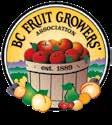
By aspiring to a strong tree fruit sector, does that mean we are there?
With recent years of poor apple returns and weather impacts on the finances of growers, there is tremendous financial pressure on the tree fruit sector. While cherry production is still ex panding rapidly, apple acreage is down from a peak of 8,500 acres five years ago to 7,100 acres today.
The adverse market and weath er conditions place pressure on growers operations and natural
ly the organizations that serve growers, such as the BCFGA.
So, how has the BCFGA respond ed? Certainly, the primary focus has been to provide evidence and approach the government and industry organizations to seek change.
Internally, within BCFGA opera tions, we adapted.
In 2021 we developed a new business model, which was adopted at our February 2022 annual meeting. The business model recognized the BC Min istry of Agriculture and Food’s direction to end association administration of government programs, and we subsequent ly withdrew from the Replant Program and the Tree Fruit Competitiveness Fund admin istration.
Fortunately, SVC and Test Or chard earnings can provide
some dividends to the BCFGA to make up for lost administration revenue.
By not administering govern ment projects, the BCFGA has a greater focus on providing val ue to its members. By providing more incentives to members (in addition to services already pro vided at a discount), the BCFGA is able to deliver more value.
The BCFGA Board of Directors has therefore approved partic ipation incentives for members certified in the Environmental Farm Plan and the Certificate of Recognition from AgSafeBC.
The BCFGA hopes to expand these incentives in the future. We also plan to introduce other benefits for growers, such as the recently announced, no-cost Good Fruit Grower subscription for BCFGA members.
Our Board of Directors is always
BCFGA will of course continue offering, at a low cost, help with the application form - known as the Labour Market Impact Assessment - for the Temporary Foreign Worker Program.
One area which the business model identified as needing more resources to properly sup port is project management.
As a result, Gail Nelson is the BCFGA’s new Horticulture and Research Project Manager, start ing September 6. We are look ing forward to better organizing our project efforts, and an im portant focus will be getting the results of projects in growers’ hands, rather than sitting on a shelf.
There is also a new emphasis on climate change projects, and BCFGA is placing more funding into climate research, which will need the extra help provided


Vice President
250-552-0638 Jamie.Rivard@td.com



by our new staff member. Growers need the most up-to-date information for gains in their operational and financial perfor mance and Gail Nelson will help BCFGA ‘up its game’ in horticulture research and out reach.
Does all of this re-focusing on member val ue distract the BCFGA from industry-wide lobbying? In a word, “no.”
The BCFGA continues to participate and lead in representing the entire industry (members and non-members of the BCF GA) on several issues, including labour, government regulation, and financial pro grams. We seek solutions to the problem of poor apple market returns and weather im pacts/adjustments. Any improvements in responding to these challenges will benefit members and non-members alike.
As a final observation, the BCFGA promotes the industry and that too provides a univer sal benefit to all fruit growers. Whether it is responding with factual information to cur rent media issues, hosting elected officials to tours or producer roundtables, or getting involved in provincial and federal elections by ensuring growers are aware of party per formance and election platforms, the BCF GA will continue to provide universal ben efits, while also providing member-specific incentives and services.
Supporting our members and the industry as a whole need not be mutually exclusive. In fact, the BCFGA business model assumes that the direct and indirect approach to im proving BCFGA members and the totality of tree fruit growers is mutually beneficial. Together we are stronger. Glen Lucas, www.bcfga.com

perspective and let me remind you of 10 marketing methods to weave into your tactical plan so you can get in front of your ideal audience.
ing with an experienced buyer of media is a great way to make sure your paid message gets presented to the right target.

Brands are finally accepting that they need to spend time and money on social media. In stagram accounts were set up, photos are being posted, and the savvy marketers have made the pivot to video. But despite all of this, reach is down, and it’s getting harder to get visibility. So what can you do? Diversify your efforts!
Anyone who has worked with me or heard me speak knows that while I am a massive advo cate of using social media as a marketing tactic, I have consis tently for the last 12 + years (as long as I have been evangeliz ing Twitter, LOL), said I see social as only one of the tools in the marketing toolbox.


However, sometimes marketers forget this and put all their en ergy into social media platforms like Instagram and use it as their go-to marketing platform, espe cially if these programs are your comfort zone. So let’s take a step back for some
Other Platforms: Don’t put all your apples in one basket – be sure to also post on other plat forms. I still love Twitter (PS it’s where all the mainstream me dia hang out) and there is also YouTube, TikTok, Pinterest and LinkedIn. Also, do remember to update your Trip Advisor.
Google Business: As an add on to the point above, make sure your Google Business page is updated and reviews are re sponded to consistently.
SEO: Adding to #2 and speak ing of Google, SEO is so power ful and can drive quality web site traffic in the background for years. You need to generate relevant, quality blog content, make sure you have an opti mized website with Google an alytics, and know how to use them. Social media posts and pins on Pinterest can continue to send traffic to your site.
Paid Media: You can control the message here, as you are paying for it. Consider adver tising on digital networks like Google and Meta, as well as in digital publications, sponsored content and even radio. Work
Influencer collaborations: This is an extension of paid social media as influencers (or content creators) require compensa tion in some form, in exchange for posting about your brand.
“Payment” can be product, an experience, or monetary, and which of these payments apply is unique to every circumstance. If you pay with money, then you control the message. It is im portant to connect with micro or macro influencers that align with your niche and values. Also you might want to work with

AG CENTRE: Chilliwack
Yale Road West, Chilliwack, BC 604-792-1301
KELOWNA: 202-150 Campion Street, Kelowna, BC 250-765-8266
HEAD OFFICE: Langley 21869-56th Avenue, Langley, BC 1-800-665-9060

CHEMAINUS: 3306 Smiley Road, Chemainus, BC 250-246-1203
Free 1-800-242-9737 www.rollinsmachinery.com

an agency or someone that understands how to examine an influencer’s audience to make sure their followers are the right tar get for you.
Earned media (PR): Work with an agen cy or pitch yourself to media, considering newsworthy or seasonal angles. Note that with earned media you do not control the message. Eighty per cent of media wins re sult from one-on-one pitching.
Markets & Events: Get in front of people. Sponsor or attend local farmer’s markets or take part in relevant events to increase brand awareness.
Trade shows: Make the business-to-busi ness connections to find synergies and get in front of trade buyers.
Loyalty or Referral Programs: Make it easy for your current customers to recommend you and earn points for future purchases. Set up programs that are baked into your point of purchase equipment and website.
Email marketing: Let’s all remember that sending an email to the right inbox can be a very effective way to gain brand exposure and even make sales. Actively grow your subscriber list with a fantastic newsletter with unique offers and first access to new products, services, or events!
Leeann Froese owns Town Hall Brands – a marketing and graphic design agency with 25 years experience branding and promoting beverage alcohol, food, and hospitality. See more at townhallbrands.com or on social @townhallbrands Do you have a way to market your product or business that I have not mentioned here or a story of failure or success with one of these tactics to share? Let me know.
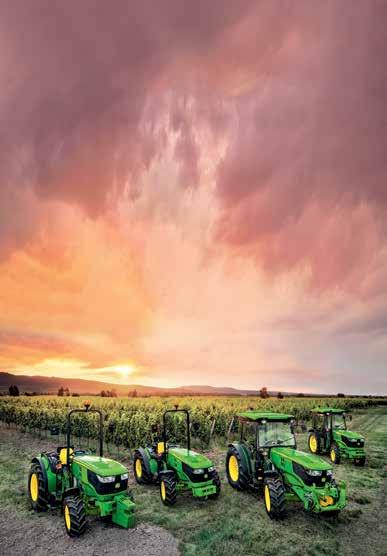

Okanagan Crush Pad Winery
• Adam Woodward
Privato Vineyard & Winery
• Christa-Lee McWatters
TIME Family of Wines
• Paul Sawler
Wine Growers British Columbia (WGBC) held its Annual General Meeting virtually on September 7, 2022, welcoming new mem bers to the Board of Directors. The Board is comprised of nine voting WGBC Directors rep resenting all British Columbia wineries. The newly elected or re-elected members of the Board of Directors are:
• Samantha Collins
Mission Hill Family Estate Winery, Mark Anthony Group
Dirty Laundry Vineyard
• Erin Korpisto
Stag’s Hollow Winery
• Charlie Baessler
Corcelettes Estate Winery
• Greg Bert Andrew Peller
• Josh Stewart Arterra Wines Canada
Continuing as ex officio non-voting members:
• Felix Egerer
BC Grapegrowers’ Association representative
“This year, BC wineries contin ued to adapt their ways of work ing to thrive through changes to tourism patterns, supply chain, labour issues, and ex treme weather events.
Despite the challenges, the loosening of public health re strictions allowed us to once again gather in person for in dustry events, the value of which cannot be understated,” said Prodan.
“While we are still in the process of understanding and quanti fying the lasting impact of the
tinued success of the BC wine industry.”
WGBC would like to thank out going members Leo Gebert (St. Hubertus & Oak Bay Winery), and Dapinder Gill (Kismet Estate Winery) for their contributions to the Board and wish all of BC wine country a fruitful harvest season.
Wine BC 2030 Long-Term Strate gic Plan is a visionary roadmap central to the future growth, vi tality, and profitability of the BC wine industry.
WGBC uses the plan as a guide in the development of their op erational objectives each year.

Owned by the Ramey Family since 2007, Blomidon Estate Winery is a boutique win ery nestled on the shore of the Minas Basin, near Canning, in the picturesque Annapolis Valley of Nova Scotia. With nearly 40 acres under vine over two distinct sites, Blomi don is committed to producing 100 per cent Nova Scotia-grown grapes and wines. Already, the winery has won numerous na tional and international awards.
Winemaker Simon Rafuse was born in Hali fax, and has been the winemaker at Blomi don Estate Winery since 2009. Like many of Canada’s best winemakers, Blomidon learned his craft both in Canada and abroad. Today, he is also an instructor with the Ca nadian Association of Professional Somme liers - Atlantic Chapter.
O&V: How did you get started in the wine industry?
Simon Rafuse: I came at winemaking in a roundabout way, while studying anthropol ogy of all things. I had become interested in wine and grape-growing, and so I did my thesis on the response to climate change in the Languedoc-Roussillon region of France. This was shortly after the big European heat wave of 2003, when a lot of growers were prioritizing sustainability and quality over yields. Anyway, I became really interested with the vineyards and winemaking, and I went from there. I did a couple of years in wine retail in Halifax and Vancouver, and then went back to school.

O&V: Where did you go to school or ap prentice?
Simon: I went to school at SupAgro Mont pellier, in France, and did a Masters of Viti


culture and Oenology there as well as the Diplôme Nationale d’Oenologue. It was a great experience, with students from all over the world. Being in France, I got to ex perience a wide range of wine styles, vari eties, and terroirs, all close by. We spent a few months in Bordeaux as well, and took class trips to Italy, Switzerland, and around France. I wouldn’t trade it for the world.
O&V: Have you worked in any other coun tries, and what was that like?
Simon: I’ve worked in the Languedoc and Alsace in France, and did a season in Cen tral Otago, New Zealand. I really enjoyed the opportunities to see something different, work in different climates, and make differ ent styles of wine. I really like travelling to wine regions. You always learn something you can apply.
O&V: What is your favourite varietal to work with, and why?
Simon: I wouldn’t say I have a favourite varietal, but I do really enjoy making spar kling wines. I like making the press cuts, all the different fermentations, and then the blending and ageing process. Dosage trials are always interesting. I find it amazing how big of an impact all those little choices you make have years down the line. It takes a lot of patience, but it’s very rewarding too when the wines are finally ready to be re leased.
O&V: What is the best thing about your job?
Simon: How different it is! It’s nice to change up what you’re doing all the time. We’re a small enough operation that it’s still very much all-hands-on-deck when some thing needs to get done. Harvest season is
obviously the big one, but I like doing all of it. Bottling and disgorging, driving the fork lift, trade shows, deliveries, whatever. It’s great.
O&V: Is there a particular wine or vintage that you have made that you are most proud of?
Simon: There are a few that stand out I suppose for different reasons. The 2009 vin tage was my first here at Blomidon, and the weather was horrible. It rained so much. I couldn’t believe what I had gotten myself into, but in the end, we managed to make some pretty good wines despite the con ditions. There’s a barrel-fermented L’Acadie Blanc from 2009 that still holds up. I’ve also been happy with some of the blended spar kling wines too, like our NV Cuvée L’Acadie and Brut Réserve. I think they’re a great rep resentation of what we’re trying to show case here at Blomidon and I’m always happy to pour them for people.
you’re planning a kitchen reno, call us first and you’ll be glad you did. We’ll save you time, money and





We’ve been in this business for over 20 years and we have a local history of many satisfied


Come and visit our new showroom! 18A - 1515 Westgate Rd, West Kelowna 778-755-6960 canadacabinet.com info@canadacabinet.com







